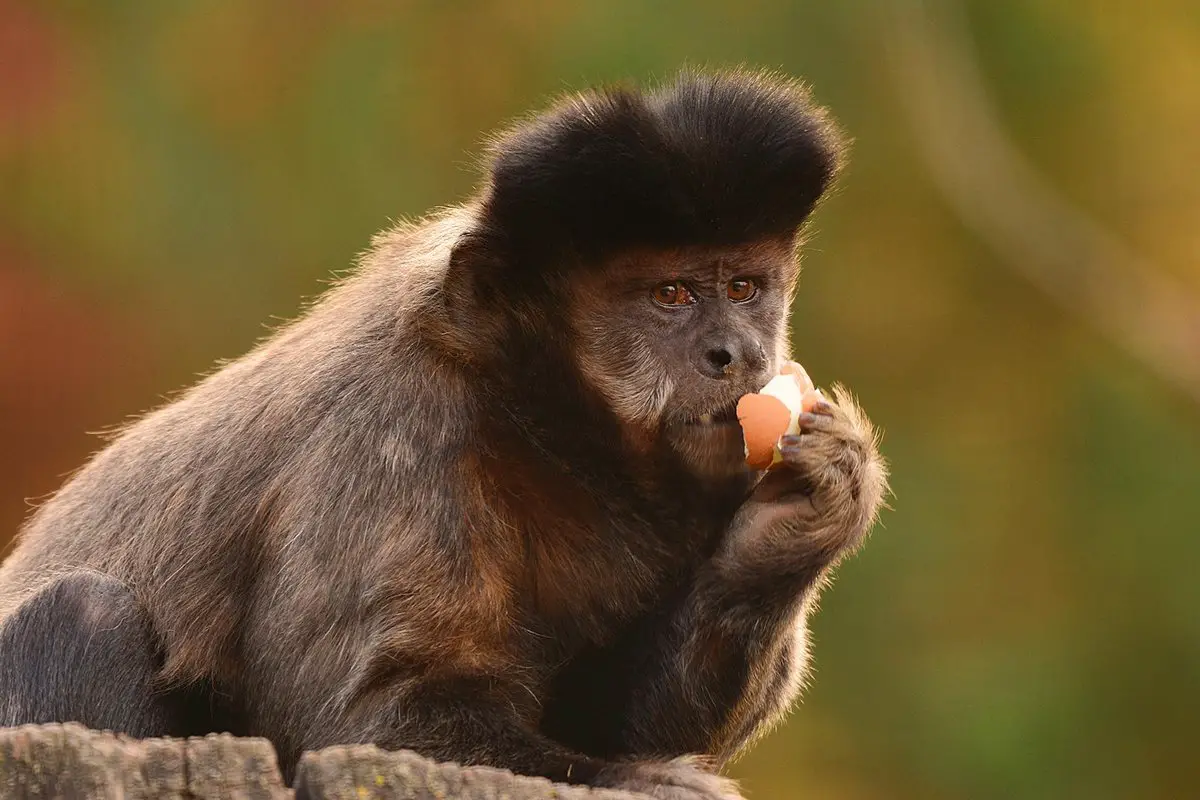Get ready to dive into the amazing world of weeper capuchin monkeys! These curious creatures, native to the lush rainforests of South America, have a lot to teach us about the wild. From their distinctive “weeping” patch to their impressive intelligence and adaptability, we’ll explore the fascinating features of weeper capuchins, their social dynamics, and the crucial role they play in their ecosystem. Let’s uncover the hidden secrets of these fascinating primates and discover why their conservation is so important.
The Weeper Capuchin Monkey: A Glimpse into their World
Ever heard of a monkey that “weeps”? No, they don’t cry tears of sadness, but the weeper capuchin monkey got its name from the distinctive black patch on its forehead that resembles a widow’s peak! These fascinating creatures are full of surprises. Let’s dive in and learn more about them!
A Closer Look: More Than Just a Weeping Patch
While initially considered a subspecies of the wedge-capped capuchin, scientists now recognize the weeper capuchin as its own unique species, scientifically known as Cebus olivaceus. Their “weeping” forehead patch, ranging from a deep brown to jet black, isn’t their only distinguishing feature. They possess longer limbs compared to other capuchin species, perfectly adapted for leaping and navigating the rainforest canopy. Their semi-prehensile tail, almost as long as their body, acts as an extra limb, providing balance and agility as they navigate their arboreal world.
Home Sweet Rainforest: Where You’ll Find Them
The Amazon rainforest is their playground! Picture these monkeys swinging through the trees of northern Brazil, Guyana, and Venezuela. You’ll find them in six South American countries—Brazil, Venezuela, Guyana, Suriname, French Guiana, and potentially even Colombia. They prefer the understory and occasionally come down to the ground, but you’ll often find them visiting the tops of tall forest trees.
Living the Group Life: Social Butterflies of the Rainforest
Weeper capuchins are highly social animals, living in tightly knit groups of 5 to 30 individuals, constantly interacting and communicating. Imagine a mix of playful youngsters chasing each other through the branches, watchful mothers caring for their babies, and the dominant male keeping a lookout for danger.
Speaking of danger, these monkeys have a clever warning system. When a predator approaches, they sound the alarm with a chorus of calls, alerting everyone to stay safe. This complex communication system extends beyond alarm calls. They have a diverse repertoire of vocalizations, including chirps, trills, whistles, and squeaks, each conveying different messages. They even use gestures and facial expressions to communicate!
Masters of Adaptation: Thriving in a Changing World
The rainforest can be a challenging place to live, but weeper capuchins are up for the challenge! They’ve developed impressive foraging skills, travelling long distances each day—sometimes up to 3 kilometers—to find the best food sources. Their diet reflects their adaptability and intelligence.
As omnivores, they feast on a delicious array of fruits, crunchy nuts, juicy insects, tender leaves, flowers, and even the occasional small animal. This diverse palate makes them incredibly adaptable to fluctuations in food availability within their rainforest home. Their foraging behavior also showcases their intelligence. They have been observed using tools, such as rocks, to crack open tough nuts and access hidden insects, demonstrating remarkable problem-solving abilities.
Protecting Our Primate Cousins: Conservation Matters
Sadly, like many rainforest inhabitants, weeper capuchins face an uncertain future. Habitat loss due to deforestation is a major concern, leading to fragmented populations and reduced genetic diversity. The good news is that conservation efforts are underway to protect their remaining habitat and ensure these incredible monkeys have a future. By understanding their unique characteristics, the challenges they face, and supporting organizations dedicated to their protection, we can all contribute to their conservation and help ensure future generations get to experience the wonder of the weeper capuchin monkey.
What Defines a Weeper Capuchin Monkey?
These little guys are instantly recognizable – they sport a black “cap” on their heads that looks like a frown, hence the name “weeper.” But don’t let the name fool you, these monkeys are far from gloomy! They’re actually quite lively and inhabit the amazing rainforests of South America. But what truly defines a weeper capuchin monkey? Let’s take a look:
Distinctive Features:
- “Weeping” Cap: The most recognizable feature is their black or dark brown cap of fur on their forehead, resembling a “weeping” or frowning expression.
- Agile Limbs: They possess longer arms and legs compared to other capuchin species, making them expert climbers and leapers in their arboreal habitat.
- Semi-Prehensile Tail: Their long, strong tail acts as an extra limb, providing balance and agility as they navigate the rainforest canopy.
Unique Characteristics:
- Highly Adaptable: Weeper capuchins thrive in a variety of rainforest environments, demonstrating their resilience and adaptability.
- Intelligent Problem Solvers: They are known to use tools, such as rocks, to crack open nuts and access food, showcasing their intelligence.
- Social and Communicative: They live in groups with complex social structures and communicate using a wide range of vocalizations, gestures, and facial expressions.
Important Roles in the Ecosystem:
- Seed Dispersers: As they consume fruits, they help disperse seeds throughout the forest, contributing to the growth of new plants.
- Pollinators: Their foraging for nectar and pollen from flowers also makes them important pollinators within their rainforest ecosystem.
Sadly, these amazing creatures are facing a big problem: deforestation. We’re losing their rainforest homes at an alarming rate. That’s why it’s so important to learn about weeper capuchin monkeys and support efforts to protect them. By understanding their unique characteristics and the challenges they face, we can all do our part to make sure these amazing primates have a future.
Learn about the typical lifespan of a Capuchin monkey, its behavior, and its habitat in our captivating article on the lifespan of Capuchin monkeys.
Where Do Weeper Capuchin Monkeys Live-and Thrive?
These clever monkeys are real homebodies, sticking to the lush, green rainforests of South America. They’re like the acrobats of the jungle, spending most of their time swinging from the branches high up in the canopy. But don’t be fooled, they’re not afraid to come down to the forest floor for a tasty treat! You can find them in six countries, stretching all the way from Brazil to Venezuela, always on the lookout for tall trees to call home.
Their South American Domain:
Weeper Capuchin monkeys have a large geographical range, spanning from the Venezuelan Amazon Basin across northern Brazil, Guyana, Suriname, French Guiana, and potentially reaching into northern Colombia.
Specific Hangouts Include:
- Venezuelan Amazon Basin: A prime location for these monkeys, offering vast stretches of rainforest.
- Forests Along Guyana’s Essequibo River: They thrive in the drier forests along this major river system.
- Forests Between Brazil’s Branco and Araca Rivers: This region provides ample habitat and food sources.
Living in tight-knit groups, they’ve got a real knack for socializing. Picture a chorus of chirps, hoots, and whistles, mixed with a flurry of gestures – that’s how they talk to each other. It’s their way of navigating their world and staying safe from any danger.
Here’s a little cheat sheet about these fascinating creatures:
| Feature | Description |
|---|---|
| Countries | 6 South American countries (Brazil, Venezuela, Guyana, Suriname, French Guiana, Colombia) |
| Favorite Hangout | Rainforest understory and canopy |
| Range | Venezuela to Guyana |
| Rainforest Role | Seed dispersers and pollinators |
| Chatterboxes | Communicate through vocalizations and gestures |
How Do Weeper Capuchin Monkeys Behave in the Wild?
Okay, so imagine this: you’re trekking through the vibrant rainforests of South America, the air thick with humidity and the sounds of exotic creatures. Suddenly, you spot them—weeper capuchin monkeys! These little guys are swinging through the trees like it’s a jungle gym, their dark “caps” making them look like tiny furry monks. Hence the name, right?
A Day in the Life of a Weeper Capuchin:
Weeper capuchins are diurnal animals, meaning they’re most active during the day. They spend the majority of their time high up in the forest canopy, their agile limbs and prehensile tails allowing them to move with incredible grace and speed.
Food is Life:
A significant portion of their day is dedicated to foraging for food. They are opportunistic omnivores, their diet changing with the seasons and availability of resources. Their keen eyesight helps them spot ripe fruits, while their sharp sense of smell leads them to tasty insects hiding beneath leaves or bark.
Social Butterflies of the Rainforest:
Living in groups of 5 to 30 individuals, weeper capuchins are highly social animals. They maintain a clear social hierarchy within their groups, with a dominant male and female typically leading the way. Communication is key to their social interactions. They utilize a complex system of vocalizations, ranging from chirps and whistles to screams and barks, to convey messages to each other.
Intelligence and Tool Use:
One of the most fascinating aspects of weeper capuchins is their intelligence. They have been observed using tools, such as rocks, to crack open tough nuts, demonstrating a level of problem-solving abilities that is truly remarkable in the animal kingdom.
Key Things to Remember About Weeper Capuchins:
- Home Sweet Home: Rainforests of South America, specifically the treetops!
- Foodie Favorites: Fruits, insects, and leaves—a little bit of everything!
- Chatty Cathys: They communicate with a variety of sounds and gestures.
- Team Players: They live in groups with a leader, but everyone cooperates and helps each other out.
- Brainy Bunch: These monkeys are intelligent problem-solvers who even use tools.
Looking for more information about the Black Capuchin monkey? Dive into our comprehensive guide to this fascinating primate, covering its physical traits, social structure, and conservation status at Black Capuchin monkey.
- Unlock English Vocabulary: The Comprehensive Con Prefix Guide - April 20, 2025
- Unlock Wordle & Scrabble Wins: Mastering Words with S, T, A, R, T - April 20, 2025
- Unlock 6000+ words beginning with he: A comprehensive analysis - April 20, 2025















